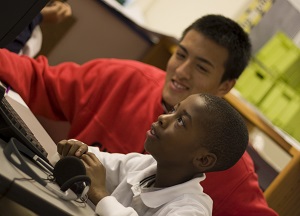By Gino Zavala, corps member serving on the Deloitte team
Before the holidays, all of my students were excited about the upcoming break from school. It was exciting hearing all the things they planned to do over vacation. They even asked me about my own plans and I told them. But I also let my students know how much I would miss them over winter break.
We all know it’s difficult going back to school after a long vacation. City Year wants to take the initiative of helping students maintain their good attendance. Before we left for vacation, I helped my students, especially those who are struggling with attendance, set attendance goals for January. I want to keep them motivated to come to school after vacation.
For the group of students who struggle with attendance I challenged them to come to school for two weeks with perfect attendance immediately following winter break. If they reach this goal they can come to lunch with me for one week.
The biggest goal I set is for my students who are really struggling with their attendance. Their goal is to come to school with perfect attendance for the week after the vacation. If they can achieve this goal, they can draw on my hands (silly, but they loved the idea) and I will also treat them with their favorite candy.
My students were excited about candy. Many of them told me, “Get ready to get me my favorite candy, Mr. Z.”
As our students return to school today after an extended winter break (thanks to the snow storm last week), I’m ready to see who will achieve this goal–and I hope all of my students do. I get really excited when I see my student achieve their goals because I know how much it means to them. It pushes me to come to school every day no matter how I might be feeling. I lead by example to prove to my students that they’re important to me and that I’ll always be there for them.
How do you celebrate students who are improving their attendance? Comment below and share your ideas with us.
About the author:
Gino Zavala is a 2013-2014 corps member serving on the Deloitte team at Irving Middle School in Roslindale.









